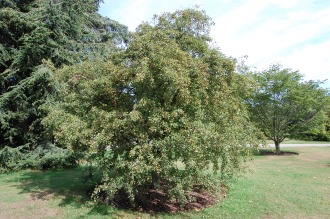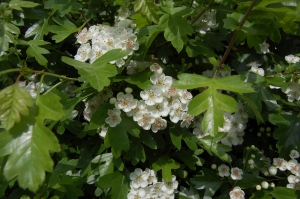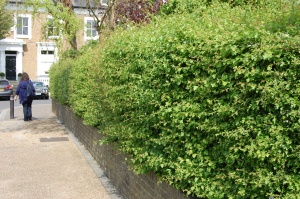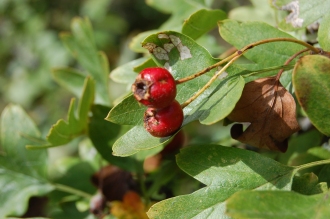Position: Full sun, will tolerate partial shade
Soil: Moist but well drained
Flowering period: Late spring
Eventual Height: 10m
Eventual Spread: 8m
Hardiness: 4a, 4b, 5a, 5b, 6a, 6b, 7a, 7b, 8a, 8b, 9a
Family: Rosaceae
Crataegus monogyna is a deciduous tree with a spreading, rounded habit. The foliage is borne on thorny branches in the form of broadly ovate to diamond shaped, deeply lobed serrate, dark green, leaves that are lighter underneath. The inflorescence is in the form of flattened corymbs of fragrant white flowers, which have pink anthers. These are followed by spherical, ovoid or ellipsoid fruit that are a shiny dark red and about 6mm in diameter.
A native species, Crataegus monogyna has a range spreading from Northwest Africa across Europe ant into Western Asia. It is commonly known as Hawthorn, May and Quickthorn in England and has been in cultivation for thousands of years, mainly as a component of ‘hedgerows’ to delineate field boundaries. Farmers also harvested it during maintenance for its firewood which burns at a high temperature with a low smoke output. It has also been studied recently for the treatment of cardiac disorders.
The etymological root of the binomial name Crataegus is derived from the Greek krataigos meaning ‘a flowering thorn’, possibly derived itself from kratos meaning ‘strength’ alluding to the hard wood usually found in the genus. Monogyna is derived from mono meaning ‘single or one’ and gyna meaning ‘ovary or seed’.
The landscape architect may find Crataegus monogyna useful as either a formal single species hedge or as part of a mixed species hedgerow. With proper maintenance a hedged of this species can form an effective livestock and people barrier due to its thorny and robust nature. If left to grow this plant will form an attractive small tree. It can tolerate coastal conditions and exposed locations.
Crataegus monogyna will grow in almost any conditions; it will tolerate any aspect, exposed or sheltered locations and any free draining non-acidic soil type.
Ecologically, Crataegus monogyna will attract pollinating insects such as bees that will feed on its nectar. All parts of this plant are mildly toxic to humans.
Crataegus monogyna requires little as a tree. If being grown as a hedge it should be pruned twice a year, in summer and autumn.










The Rosaceae family may contain traces of cyanide within its seeds – but the other parts of the root are non toxic! The leaves, blossoms, and berries are regularly used medicinally.